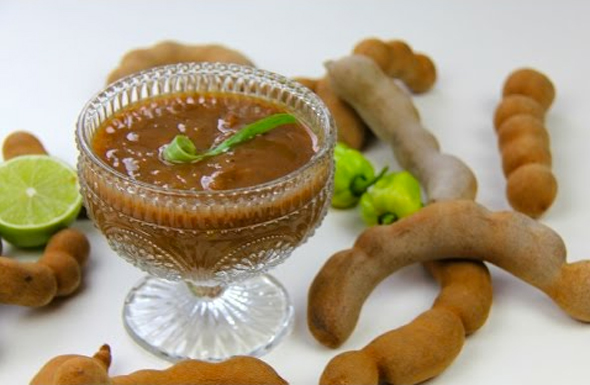Mama’s Punjabi Recipes: Imbli di Chatni (Tamarind Chutney)
There are two chutneys that are commonly found in most Indian restaurants, no matter where you go: pudine ki chatni (mint chutney) and imbli ki chatni (tamarind chutney) and these are usually served as dipping sauces to go with all types of fried snacks like samosas, pakores and tikkis or as condiments with fast foods like gol gappas, dahin bhalle or pappri chaat.
Unfortunately, in most restaurants both these chutneys are cut with too much water and are runny which makes them thin and hard to savor with snacks. To be true to their taste, chutneys must have the thickness and sticking power of a true sauce. You should be able to see the mint and tamarind adhere to the surface in order to enjoy the flavor.
The tamarind tree produces edible, pod-like fruit which is used not only in cuisines but also in medicines and metal polish. The tree is indigenous to Africa and the Indian Subcontinent and was introduced to South East Asia and Mexico and South America in the 16th century. The tree is long lived, can grow to 60 feet tall and survives in many types of soil. The flesh of the mature fruit is sweet and sour, reddish-brown and the pod contains flattened, glossy brown seeds.
The fruit is high in calories and carbohydrates as well as magnesium, iron, phosphorus and potassium and vitamins B1, B2 and B3. In Southeast Asia, it is used as a poultice or balm applied to the foreheads of fever sufferers. Tamarind contains tartaric acid which is a weak acid that can remove the green coat that can cover copper or brass utensils, statues or lamps.
The nice part of tamarind chutney is that once it is made, you can keep it in a jar in the fridge for a long time and it won’t spoil.
Ingredients:
100 gm imbli (tamarind) – dried pressed packet
200 gm gur (brown rock cane sugar, jaggery)
2 cups thanda pani (cold water) – about 600 ml
1 tsp saunth (dried ginger powder)
1 tsp mirch (red pepper)
1/2 tsp jeera (cumin powder) – if desired
Directions:
1.Take the imbli out of the packet and place it into a pot with 2 cups of water. Crush the gur into small pieces and also add it into the water.
2.Turn the heat on and let the water come to a boil. When the water has reduced to half, then turn the heat off and let the mixture cool down.
3.Once it is cool, then mash the softened imbli with your hands and remove the outer skin and any seeds.
4.Now add the red pepper and saunth and mix well. Do not add salt to this chutney. If you want to, add the jeera in too and mix well.
5.Pour into a jar and keep in the fridge for long preservation.
6.Imbli di chatni is best served with snacks like gol gappas, samosas, pakore or with dahin bhalle.
MAMA’S TIP OF THE WEEK
CAREFUL TAKING DIGESTIVE POWDERS THAT HAVE TOO MUCH SALT
In the Indian Subcontinent, there are many foods that can create gas or indigestion, like channe (chickpeas) or rajma (kidney beans) or gobi (cauliflower) and can leave you feeling uncomfortable. Many times well-meaning people will suggest churan (digestive powder) or even ajawain (carom or bishop’s weed) to help with the upset stomach. But usually churan has lots of salt in it and ajawain has to be taken with at least a half teaspoon of salt to make it work. These aids are not recommended for people with hypertension as the salt will only elevate their blood pressure.

Shakuntla Malhotra is a skilled cook of Punjabi dishes made in the old-fashioned style that she learnt as a young woman in her ancestral home in Lyallpur (since renamed Faisalabad), India before it became part of Pakistan after the Partition in 1947. People have often admired her cooking for its simplicity and taste that comes with each mouthful. Even in her mid-eighties, she continues to cook daily and agreed to share some of her delectable Punjabi recipes.

